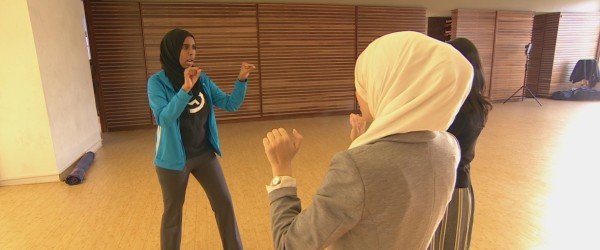For the past few weeks I have become increasingly concerned about many of the women in my life. Canada, these days, has seen a rise in Islamophobic attacks, the majority of which target Muslim women. The majority of the attacks have happened in the province of Ontario, but women across Canada report feeling unsafe, including in Manitoba, Quebec and Alberta. There have been Muslim women who have been verbally or physically assaulted and others who have received threatening or racist comments/notes. Women of colour have also been impacted, regardless of their religious associations, as they are mistaken as “Muslims.”
Muslim and non-Muslim communities have responded in pretty amazing ways, including initiatives like BuddyUpTO, #IllRideWithYou, solidarity protests, vigils and the sharing of sacred spaces. All of this is happening at the grassroots level, and while no initiative is perfect, they show that Muslim communities can work in solidarity not only among themselves but with others to raise awareness, share resources and fight back. One of the most publicized initiatives is the creation of self-defence workshops, which MMW’s Shireen discussed a few weeks ago. Workshops are being offered to Muslim women primarily in Toronto and Calgary, where some of the most recent attacks have happened.
Self-defence for women is not a new thing. In fact, several university campuses offer it as an approach to the 1 in 4 women who are raped in Canadian and American campuses (a number that is often challenged). Self-defence also figures in Canadian and American developing programming, which is currently supporting projects in Kenya that focus on “empowering women” through self-defence. Self-defence is said to reduce the risk of being raped and empower women to fight back if need be. Self-defence is also said to place power in women’s hands instead of continuing to perpetuate the idea that men hold power over them and can victimize them at any point in time.
As someone who has seen women being attacked, who has worked with survivors of sexual violence in post-secondary settings, and who is currently working on international development programming addressing sexual violence, I recognize the need to develop non-state centric strategies for women, and other “minorities,” to protect themselves and feel that they have the tools to fight back if they need to.
God only knows, there is nothing that I want more right now than making sure Muslim and women of colour are safe.
However, I do have concerns at the policy-level. Despite my field of study in policy and administration, I am not a big fan of the state or state-centric work. In fact, I am pretty much aware of the colonial, racist and gendered aspects of the settler state (such as Canada) and this position makes me very well cheer for grassroots activism and initiatives. Yet, I am also pragmatic. Policies and the law are essential to our lives at different levels. They regulate our behaviour, set boundaries, provide “solutions” and oversee “justice” (I am skeptical of all this ideas). Therefore, the state still has monopoly over the “legitimate” use of violence, it has the funds to support social services, it has the tools to punish (i.e. jails), and it determines who has access to all of this.
But laws and policies can be very gendered, sexist, racist and Islamophobic. Canada has a history of pretty racist and sexist laws and to date Bill C-3 in Canada continues to discriminate against Indigenous women by determining their “Indian” status according to old and outdated marriage laws; Bill C-36 attempts to regulate sex work in pretty dangerous ways that will affect several women, primarily women of colour; Bill C-24 created second-class citizens, many of whom are people of colour; and Bill C-51 still targets Muslims, environmental and Indigenous activists.
All of these need to change. And that entails policy work and advocacy.
Thus, my concern with the focus on self-defence without elements of policy work and education, which continue to be underdeveloped in my opinion, put women, particularly women of colour and of faith, at the mercy of a legal and policy system that has always had tints of sexism and racism. As part of my thesis work I recently read Kirstin Bumiller’s book In an Abusive State: How Neoliberalism Appropriated the Feminist Movement Against Sexual Violence. Bumiller’s book recounts the institutionalization of white-Western feminist movements during the 60s, 70s and 80s and the effects that such a thing has had on feminist movements as a whole and the impact it had on women of colour. Whether I do not necessarily agree with everything she says, Bumiller does an excellent job at looking at the different approaches that feminist movements, particularly white movements, developed to fight sexual violence and violence against women. These approaches included the creation of “rape clinics” (modern sexual assault centres and the alike) and self defence-classes for women, many of which were eventually funded (and de-funded) by the government in an attempt to show their political will to address sexual and gender-based violence (SGBV). However, something that is key to Bumiller’s storytelling of this particular fact is the issue of policy and the law.
When women are taught self-defence as a solution to a problem, then they are expected to “solve” the problem by themselves and policies and laws are applied harshly to women who are unable to do so. Think, for instance, women who receive self-defence training and for whatever reason cannot avoid assault or rape- whether it is because they freeze, their attacker is well-versed in self-defence or weapons are involved- what happens then? Bumiller’s account shows that women who received training and still were attacked had a harder time taking their attackers to court, the assumption being, if you got the training and are able to defend yourself, then you must be lying about the attack or it must have been consensual. Women who were able to take their attacks to court were not considered to be “worthy victims,” which we know has a great impact in how cases of violence play for women. What is more, Bumiller shows that the fact that self-defence classes do not address intersecting issues, women of colour still faced a lot of violence, less help from the authorities, less empathy in the courtroom and further criminalization.
One of the major problems, in my view, was that the policy and advocacy work to address the issue of SGBV is still ongoing and has taken forever, but it has been seldom well-coordinated with grassroots initiatives. I am not saying self-defence workshops should not happen. At all. You got to do what you got to do. Yet, it cannot stop there. Self-defence cannot be the goal. For these approaches to work we need a lot of work at the policy level. If Islamophobia is not addressed there, no amount of self-defence workshops will help Muslim women and women of colour navigate the system or receive support when they need it.



2 Comments
I think this writer needs to step outside of herself for a moment. In one paragraph she supports women-centered solutions and non-state sponsored solutions to these Islamophobic incidents, yet in the last paragraph she says it can’t stop there. What is HER solution? We can’t critique things to death without providing viable options. Also, this really feels like she is slightly shaming Muslim women who have initiated these self-defense classes as a reaction to these events which is a shame. I’m sure that wasn’t her point, but I’m not even clear what her point is.
Thank you for the comment Khadijah. My intent was never to shame Muslim women who partake in these efforts. On fact I have several friends who engage in them. The point of the article, if you read it carefully, is to say that in reality we will also need to engage in policy advocacy to make sure that laws and policies actually protect Muslim women… Why? Because if self defense is the only element, Muslim women who experience violence and islamophobia will continue to do so through policies and laws. I hope that clarifies the article.